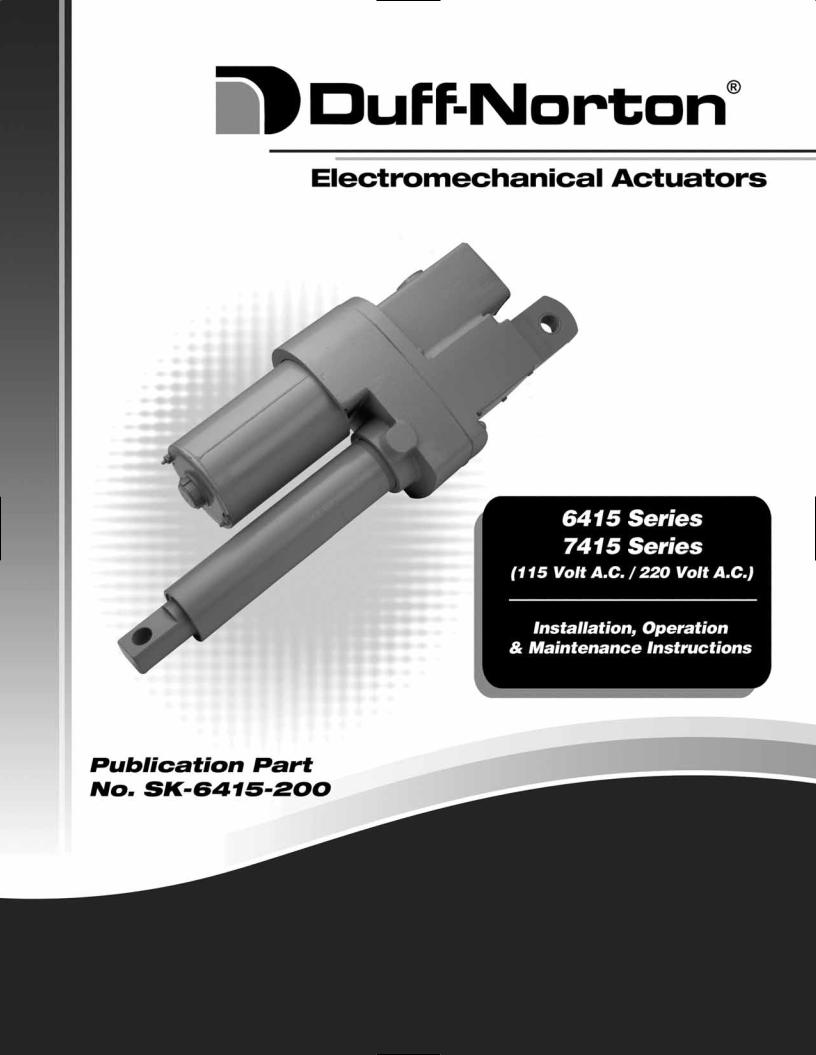Duff-Norton SK6415-200 User Manual

 CAUTION!
CAUTION!
This manual contains important information for the correct installation, operation and maintenance of the equipment described herein. All persons involved in such installation, operation, and maintenance should be thoroughly familiar with the contents. To safeguard against the possibility of personal injury or property damage, follow the recommendations and instructions of this manual and keep it for further reference.
 WARNING!
WARNING!
The equipment shown in this manual is intended for industrial use only and should not be used to lift, support, or otherwise transport people unless authorized in writing by Duff-Norton.

SECTION I
1-1
1-2
1-3
1-4 TABLE 1-4 TABLE 1-4-1 1-5 FIGURE 1-6
SECTION II
2-1
2-2
2-3
2-4
SECTION III
3-1
SECTION IV
4-1
4-2
4-3
4-4
4-5
SECTION V
FIGURE 5-1 5-1
SECTION VI
6-1 FIGURE 6-1A FIGURE 6-1B 6-2
FIGURE 6-2 6-3
TABLE OF CONTENTS
|
PAGE |
GENERAL INFORMATION |
|
General |
3 |
Industrial Use Only |
3 |
Factory Preparation |
3 |
Specifications |
3 |
6415 Series DC Actuator Specifications |
3 |
6415 Series DC Super Pac Actuator Duty Cycle |
3 |
Warranty and Warranty Repair |
3 |
Dimensions and Specifications |
4 |
INSTALLATION |
|
Installation Procedures |
5 |
Limit Switch Adjustment |
5 |
Post-Installation Procedures |
5 |
Potentiometer Adjustment |
6 |
OPERATION |
|
Operational Procedures |
6 |
MAINTENANCE |
|
Lubrication |
7 |
Required Tools |
7 |
General Procedures |
7 |
Disassembly |
7 |
Assembly |
8 |
ILLUSTRATED PARTS LIST |
|
Exploded Illustration 6415 & 7415 AC Actuator |
12 |
Parts List |
13 |
TECHNICAL ILLUSTRATIONS |
|
Brake Alignment |
14 |
Brake Spring, Motor and Pinion Coupling Alignment |
14 |
Brake Spring, Motor and Pinion Coupling Alignment |
14 |
Limit Switch Wiring Diagram |
15 |
Limit Switch Wiring Diagram, 6415 & 7415 Series AC Actuator |
15 |
Limit Switch Assembly |
15 |

SECTION 1
GENERAL INFORMATION
1-1. GENERAL
This manual provides instructions for the installation, operation and maintenance of the Duff-Norton 6415 & 7415 Series AC actuator. It includes proper procedures for the disassembly, cleaning, inspection, rebuilding and assembly of the actuator. To ensure efficient, long, satisfactory use of this unit, these instructions should be followed closely.
1-2. INDUSTRIAL USE ONLY
The actuators described and illustrated in this manual are intended for industrial use only and should not be used to lift, support or otherwise transport people, unless you have a written statement from Duff-Norton Company which authorizes this actuator unit, as used in your application, as suitable for moving people.
1-3. FACTORY PREPARATION
Each actuator is carefully assembled and tested at the factory to ensure that the motor and the mechanical components will function properly and that the actuator will lift its rated load.
The brake is preset at the factory and no further adjustment is required. With proper maintenance, this brake prevents the actuator from self-lowering.
The actuator is pre-lubricated at the factory and thus requires minimum maintenance.
Limit switches are checked at the factory for proper functioning.
External wires are provided for customer hookup. Wires are color coded as to direction of travel of the actuator (see wiring diagram, Figure 6.2).
1-4. SPECIFICATIONS TABLE 1-4.
|
|
Speed |
|
Amps |
||
|
(in/min) |
|
||||
|
|
|
|
|||
Applied |
Standard |
|
Standard |
Standard |
|
Standard |
Load |
115 Volt |
|
220 Volt |
115 Volt |
|
220 Volt |
(lbs.) |
Motor |
|
Motor |
Motor |
|
Motor |
|
(60 Hz) |
|
(50 Hz) |
(60 Hz) |
|
(50 Hz) |
500 |
52 |
|
44 |
5.00 |
|
1.70 |
|
|
|
|
|
|
|
1000 |
51 |
|
42 |
5.50 |
|
1.70 |
|
|
|
|
|
|
|
1500 |
50 |
|
41 |
6.20 |
|
2.00 |
|
|
|
|
|
|
|
1-5. WARRANTY AND WARRANTY REPAIR
Subject to the conditions stated herein, Duff-Norton will repair or replace, without charge, any parts proven to Duff-Norton's satisfaction to have been defective in material and workmanship. Claims must be made within one year after date of shipment. Duff-Norton will not repair or replace any parts that become inoperative because of improper maintenance, eccentric loading, overloading, chemical or abrasive action, excessive heat, or other abuse.
Equipment and accessories not of Duff-Norton's manufacture are warranted only to the extent that they are warranted by their manufacturer, and only if the claimed defect arose during normal use, applications and service. Equipment which has been altered or modified by anyone without Duff-Norton's authorization is not warranted by Duff-Norton. EXCEPT AS STATED HEREIN, DUFF-NORTON MAKES NO OTHER WARRANTIES, EXPRESS OR IMPLIED, INCLUDING WARRANTIES OF MERCHANTABILITY AND FITNESS FOR A PARTICULAR PURPOSE.
If you have any questions concerning warranty repair, please contact the Duff-Norton Company.
Authorization for return must be received from the Duff-Norton Company before returning any equipment for inspection or warranty repair.
3

FIGURE 1-6. DIMENSIONS AND SPECIFICATIONS
WARNING:
1.Some actuator external surface temperatures may reach 230°F at or near maximum allowable duty cycle.
2.Do not operate actuator before setting limit switches.
3.Position hooded vent to prevent moisture and dirt from entering actuator (see instruction and maintenance sheet).
4.The actuator is not recommended for use in applications where it can be jammed. Examples of jamming include overtraveling the limit switches and jamming the nut and screw internally at the extreme ends of the stroke, or driving the actuator against an immovable object and thus overloading the actuator severely. Therefore consult Duff-Norton Engineering if jamming is expected.
4

SECTION II INSTALLATION
2-1. INSTALLATION PROCEDURES
Use Figure 6-2 as a guide to properly attach the SPA 6415 & 7415 AC actuator to your power source.
2-2. LIMIT SWITCH ADJUSTMENT
CAUTION
Disconnect power before making any adjustments to the limit switches.
IMPORTANT
Before attempting to set limit switch nuts by these instructions, be certain that the red and blue motor leads and the switch leads are connected properly per Figure 6-2. Unless leads are connected exactly as shown, the following steps will be meaningless.
1.Setting Retracted Position
A.Do not install actuator in the intended application at this time.
B.With nut retainer “A” installed in actuator and the translating tube unstrained, operate actuator toward retracted position until limit switch nut “B” trips limit switch (see Figure 6-3).
NOTE
Translating tube may jam and rotate prior to tripping limit switch.
C.Rotate the translating tube by hand until distance between the housing clevis hole centerline and the translating tube clevis hole centerline equals the desired closed height. This centerline to centerline dimension is not to be less than the retracted centerline to centerline dimension listed in Figure 1-6. If the two clevis end holes are not oriented as required, rotate the translating tube no more than 1/2 turn in either direction until they are properly oriented.
D.Install actuator in application and check drift. Slight readjustment in switch actuation may be attained by removing nut restrainer “A” and rotating limit switch nut “B” (1 notch of
rotation = .05 in. of screw travel). Replace nut restrainer, “A”.
2.Setting Extended Position
A.Restrain the translating tube against rotation by hand. Operate the actuator, toward the extended position, until the distance between the housing clevis hole centerline and the translating tube clevis hole centerline equals the desired extended height. This centerline to centerline dimension is not to exceed the
extended centerline to centerline dimension listed in Figure 1-6.
B.Remove nut restrainer “A” and rotate limit switch nut “C” (see Figure 6-3) until it activates the limit switch.
C.Replace nut restrainer “A”.
D.Install actuator in application and check the unit's drift. Slight readjustment in switch actuation may be attained by removing nut restrainer “A” and (1) rotating limit switch nut “B” to adjust retracted position or (2) rotating limit switch nut “C” to adjust extended position (1 notch of rotation = .05 in. of screw travel).
E.After adjusting limit switch nuts,
replace nut restrainer “A”. Operate the actuator and readjust limit switch nuts as necessary to achieve desired travel.
2-3. POST-INSTALLATION PROCEDURES
After actuator installation, position the air vent to prevent moisture and dirt from entering the actuator. Vent can be repositioned by loosening the set screw and rotating the outer air tube into which the air vent is threaded. Spot drill and re-tighten set screw.
If necessary, an elbow (1/8" female x 1/8" male pipe thread) can be used for more effective positioning.
FOR UNITS WITH POTENTIOMETER
2-4. POTENTIOMETER INSTALLATION
1.Loosen pot locknut and remove from actuator.
2.For best accessibility, solder leads to pot at this time.
3.Limit switches should be set for extreme limits of travel per instructions. Limit switch cam adjustments should be made per paragraph 2 prior to potentiometer installation.
CAUTION
DO NOT ENGAGE POTENTIOMETER SHAFT GEAR TEETH WITH PLASTIC WORM BEFORE READING THE FOLLOWING PROCEDURE. FAILURE TO ADHERE TO THE FOLLOWING PROCEDURE COULD CAUSE DAMAGE TO THE POTENTIOMETER.
4.Retract actuator translating tube until stopped by limit switch.
5.a. FOR TRAVELS UP TO 9” (SINGLE TURN POT):
i.Turn pot shaft counterclockwise until resistance between terminal S and CCW is approximately 100 ohms. This will be the pot’s full retracted position.
5
